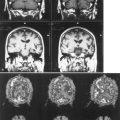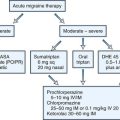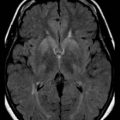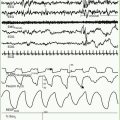Chapter 51F Vascular Diseases of the Nervous System
Central Nervous System Vasculitis
Isolated vasculitis of the central nervous system (CNS) is rare. Although only one or two cases may be seen in a year even in large referral centers, isolated CNS vasculitis is nonetheless frequently invoked in the differential diagnosis of obscure neurological illnesses (Berlit, 2004). The process of diagnosing and treating isolated CNS vasculitis often places the neurologist on the horns of serial dilemmas. There are no characteristic clinical features; the results of routine laboratory investigations, both medical and neurological, are either normal or nonspecific. Short of brain biopsy, only one test may be helpful—catheter cerebral angiography—but this invasive procedure has the additional drawbacks of low sensitivity and specificity. It is all too often negative in pathologically documented cases of the disease. Angiographic changes deemed “typical” or even “classical” of vasculitis prove just as often to be the result of entirely different disease processes. The consequence of missing the diagnosis of CNS vasculitis is the death of the patient; the consequence of delay in diagnosis is likely to be severe disability. Current therapies are highly toxic. Use of newer, less toxic alternatives is still dependent on limited anecdotal evidence.
Types of Central Nervous System Vasculitis
When vasculitis is clinically and pathologically restricted to the CNS, it is referred to as a primary or isolated CNS vasculitis. Early descriptions of this disorder included the term granulomatous, but this histological feature, although frequent, is not required for diagnosis (Miller et al., 2008). This chapter covers isolated CNS vasculitis and the CNS vasculitides associated with cutaneous herpes zoster infections, drug abuse, lymphoma, and amyloid angiopathy.
The CNS also may be involved in widespread systemic vasculitis, usually polyarteritis nodosa or Wegener granulomatosis. These disorders, which are discussed in Chapter 49A, rarely present with isolated CNS manifestations. Although vasculitis is often proposed as the explanation for CNS dysfunction in systemic lupus erythematosus, it is actually quite rare in this disease (Ramos-Casals et al., 2006).
Isolated Central Nervous System Vasculitis
Clinical Findings
The mode of onset is acute or subacute. Although the classic picture is one of progressive, cumulative, and multifocal neurological dysfunction, there are abundant exceptions, including patients whose presentation suggests cerebral tumor, chronic meningitis, demyelinating disease, acute encephalitis, myelopathy, simple dementia, and even degenerative disorders. Although often mentioned in the differential diagnosis, especially in patients without risk factors, isolated CNS vasculitis rarely causes stroke (Wiszniewska et al., 2003). When isolated CNS vasculitis presents as a stroke, it is usually due to intracerebral hemorrhage, which occurs in approximately 15% of patients at some time in the illness. The disease rarely causes single cerebral infarcts or transient ischemic attacks in the absence of clinical or laboratory evidence of widespread CNS inflammation, verified by cerebrospinal fluid (CSF) pleocytosis.
Nonfocal symptoms such as headache and confusion are the most common presenting complaints. Aside from confusion, the most common sign at presentation is hemiparesis. Ataxia of limbs or gait, focal cortical dysfunction including aphasia, and seizures are also frequent. Virtually every neurological sign or symptom has been reported at least once (Schmidley, 2000). Nonspecific visual complaints occur in approximately 15% of patients, but disorders of specific ocular motor nerves, optic nerve, or visual fields are much less common. Systemic symptoms are generally absent. Fully developed cases almost invariably show signs and symptoms of progressive, widespread neurological dysfunction; however, occasional patients present with a multiple sclerosis–like course of early relapses and partial remissions or clinical manifestations largely restricted to one part of the nervous system, such as the spinal cord or cerebellum.
Laboratory Findings
Although some publications emphasize the value of angiography in making the diagnosis, cerebral angiography has been entirely normal in many pathologically documented cases, and the arteriographic changes of vasculitis, when seen, are not specific (Schmidley, 2000). Given its lower spatial resolution, magnetic resonance angiography is unlikely to be useful either.
It is our opinion that many published cases of angiographically diagnosed CNS vasculitis, including the so-called benign variant, represent misinterpretation or overinterpretation of nonspecific angiographic changes, unconfirmed by a tissue diagnosis. Until the pathological processes underlying these cases are established, the use of more circumspect terms such as cerebral angiopathy or reversible segmental cerebral vasoconstriction (RSCV), also known as Call-Fleming syndrome, is appropriate. The latter is a poorly defined syndrome that appears to be induced by several different stimuli (Calabrese et al., 2007). The typical patient with RSCV is a woman between the ages of 20 and 50, with acute onset of headache and focal neurologic deficits. Often, the headache can be so severe (“thunderclap”) as to suggest aneurysmal subarachnoid hemorrhage. By definition, angiographic changes “typical” for vasculitis are seen, but these invariably improve, usually in a timeframe incompatible with resolution of vasculitis. The improvement often takes place concurrent with the administration of prednisone, other immunosuppressive agents, calcium channel blockers, or magnesium but cannot be confidently attributed to any therapy, since an identical degree of resolution has occurred in the absence of any specific therapy. Brain biopsy has been negative in the few cases where it was done; CSF, although not invariably normal, is much more likely to be normal than in true CNS vasculitis. A variety of drugs have been implicated in RSCV, most commonly the ergots, other antimigraine therapies, over-the-counter sympathomimetics, cocaine, and most recently the selective serotonin reuptake inhibitors. The syndrome is not progressive and seldom recurs. Optimal therapy is unknown; often a brief course of prednisone or calcium channel blockers is given. It is prudent to discontinue any implicated drugs.
Approach to Diagnosis
In several series of patients investigated with both brain biopsy and angiography, the latter has proved to be an extremely poor predictor of pathological findings (Alrawi et al., 1999; Chu et al., 1998; Kadkhodayan et al., 2004). In the studies cited, angiograms considered to be typical of CNS vasculitis, with multifocal stenosis and “sausaging” of luminal profiles, were present more often in patients with other diagnoses or negative biopsies than in those with histologically proven CNS vasculitis. Just as important, biopsies that were negative for vasculitis often provided another diagnosis with entirely different therapeutic implications. The most frequent nonvasculitic diagnoses were neoplastic and infectious.
Therapy
High-dose prednisone plus cyclophosphamide is currently the treatment of choice (Birnbaum and Hellmann, 2009). Some patients recover or stabilize on corticosteroid therapy alone, but most progress. The results of therapy are difficult to interpret because of (1) the rarity of the disorder, so that centers do not accumulate large numbers of patients; (2) the difficulty of unequivocally establishing the diagnosis other than by biopsy; (3) the inclusion of patients with the so-called benign form of CNS vasculitis (whose benignity, however, can be established only in retrospect); and (4) the inclusion of patients with diagnoses based only on angiography. Intravenous immunoglobulin has been administered with success a few times but in poorly documented cases. Experience with other immunosuppressive agents is very limited (Chenevier et al., 2009; Salvarini et al., 2008); the good outcomes reported may merely reflect publication bias.
Central Nervous System Vasculitis Associated with Other Disorders
Cutaneous Herpes Zoster Infection
CNS vasculitis associated with herpes zoster (see Chapter 53B) usually presents as a severe hemispheric stroke in the weeks or months following an ipsilateral ophthalmic division eruption in an older adult (Gilden et al., 2002). Angiography shows ipsilateral segmental stenoses of distal internal carotid and the proximal middle and anterior cerebral arteries. Evidence of varicella-zoster virus is found in the same segments of these vessels, which are inflamed and necrotic. Presumably, the virus reaches the affected arterial segments via intracranial projections of the ophthalmic division of the trigeminal nerve. The effectiveness of acyclovir and corticosteroids for this syndrome is unknown, but their use seems reasonable. A second type of cerebral vasculitis associated with herpes zoster is less common and less well understood. It is a diffuse small-vessel vasculitis in the absence of parenchymal infection and can follow noncephalic as well as ophthalmic eruptions of zoster.
Drug Abuse
The usual scenario in “CNS vasculitis” associated with drug abuse is subarachnoid or intracerebral hemorrhage following use of methamphetamine or another sympathomimetic, including “look-alike” diet pills. Route of administration has usually been intravenous, but cases have occurred after oral use. It is uncertain whether the “vasculitis” reported in the angiograms of these patients is a true inflammatory process or a vasculopathy (akin to RSCV) induced by an unusual reaction to the drug, hypertension, or other factors (Ho et al., 2009). When the case reports are examined critically, it becomes obvious that (1) only one has been pathologically documented as vasculitis; (2) the “vasculitis” has sometimes occurred after the first use of the drug, an event unlikely to be immunologically mediated; and (3) the course is usually monophasic rather than progressive and multifocal, as one would expect in a true vasculitis. Because drug abusers (and their dealers) are famously unreliable, it is difficult to be certain which illicit drugs were used and in what doses, and it is virtually impossible to trace inert substances used as fillers, which nonetheless might be responsible for some of the clinical events. Relatively few cases have been fully documented toxicologically. Experimental animals given sympathomimetic drugs chronically do not, in most models, develop a CNS vasculitis.
Many case reports claim cure using corticosteroids, but this may only represent the natural history of the syndrome. Before entertaining this diagnosis in intravenous drug abusers, exclude the other definitely treatable causes of stroke in this population—subacute and acute bacterial endocarditis being most important. Additional causes of cerebral embolization in drug abusers include talc and air emboli, the latter caused by inadvertent injection of air into the internal or common carotid artery while attempting to puncture the internal jugular vein. Intravenous drug abusers are at risk for hepatitis-associated polyarteritis nodosa, which can involve either the peripheral or the central nervous systems. A nonspecific cerebral vasculitis may occur in cocaine users, although vasculitis is not present in the brains of most patients with cocaine-associated strokes (Aggarwal et al., 1996).
Lymphoma
Rare patients with systemic lymphoma, nearly always Hodgkin disease, may have an isolated CNS vasculitis in the absence of parenchymal or meningeal involvement by lymphoma (Rosen et al., 2000). This association, not noted for other malignant neoplasms, naturally leads to speculation that the Hodgkin disease somehow triggers or provokes the vasculitis. In some patients, the CNS vasculitis has developed concurrent with or following disseminated herpes zoster infection, further confounding the picture. In the nonzoster cases, the CNS disorder improves with remission of the Hodgkin disease, brought about by chemotherapy or radiotherapy.
Amyloid
Cerebrovascular amyloid may coexist with a CNS vasculitis (Scolding et al., 2005). In most instances, the vascular amyloid is the same type that accumulates in vessels and senile plaques in Alzheimer disease (see Chapter 66). The relationship, if any, between these two usually distinct processes is not clear. Amyloid deposited in any location frequently evokes a limited degree of giant-cell macrophage response and may elicit a sparse lymphocytic infiltrate as well. Therefore the vasculitis may just represent an excessive degree of inflammatory response to the vascular amyloid. The vasculitis also could cause amyloid deposition. Cytokines such as interleukin-1 increase production of amyloid precursor protein by endothelium, at least in vitro.
Most patients have presented with a progressive clinical picture consistent with vasculitis, including abnormal spinal fluid. Although cerebrovascular amyloid angiopathy without vasculitis almost always presents with intraparenchymal hemorrhage (see Chapter 51B), hemorrhage only occurs in about 30% of patients with amyloid-associated CNS vasculitis. In the absence of a better understanding of this disorder, treatment should be the same as for isolated CNS vasculitis.
Aggarwal S.K., Williams V., Levine S.R., et al. Cocaine-associated intracranial hemorrhage: absence of vasculitis in 14 cases. Neurology. 1996;46:1741-1743.
Alrawi A.B., Trobe J.D., Blaivas M., et al. Brain biopsy in primary angiitis of the central nervous system. Neurology. 1999;53:858-860.
Berlit P. Cerebral vasculitis. Nervenarzt. 2004;75:105-112.
Birnbaum J., Hellmann D.B. Primary angiitis of the central nervous system. Arch Neurol. 2009;66:704-709.
Calabrese L.H., Dodick D.W., Schwedt T.J., et al. Reversible cerebral vasoconstriction syndromes. Ann Intern Med. 2007;46:34-44.
Chenevier F., Renoux C., Marignier R., et al. Primary angiitis of the central nervous system: response to mycophenolate mofetil. J Neurol Neurosurg Psych. 2009;80:1159-1161.
Chu C.T., Gray L., Goldstein L.B., et al. Diagnosis of intracranial vasculitis: a multi-disciplinary approach. J Neuropathol Exp Neurol. 1998;58:30-38.
Gilden D.H., Lipton H.L., Wolf J.S., et al. Two patients with unusual forms of varicella-zoster virus vasculopathy. N Engl J Med. 2002;347:1500-1503.
Ho E.L., Josephson S.A., Lee H.S., et al. Cerebrovascular complications of methamphetamine abuse. Neurocrit Care. 2009;10:295-305.
Kadkhodayan Y., Alreshaid A., Moran C.J., et al. Primary angiitis of the central nervous system at conventional angiography. Radiology. 2004;233:878-882.
Miller D.V., Salvarini C., Hunder G.G., et al. Biopsy findings in primary angiitis of the central nervous system. Am J Surg Pathol. 2008;33:35-43.
Ramos-Casals M., Nardi N., Lagrutta M., et al. Vasculitis in systemic lupus erythematosus: prevalence and clinical characteristics in 670 patients. Medicine. 2006;85:95-104.
Rosen C., DePalma L., Morita A. Primary angiitis of the central nervous system as a first presentation in Hodgkin’s disease: case report and review of the literature. Neurosurgery. 2000;46:1504-1508.
Salvarini C., Brown R.D., Calamia K.T., et al. Effect of tumor necrosis factor alpha blockade in primary angiitis of the central nervous system resistant to immunosuppressive therapy. Arthr Rheum. 2008;59:291-296.
Schmidley J.W. Central Nervous System Angiitis. Boston: Butterworth-Heinemann; 2000.
Scolding N.J., Joseph F., Kirby P.A., et al. A-beta-related angiitis: primary angiitis of the central nervous system associated with cerebral amyloid angiopathy. Brain. 2005;128:500-515.
Wiszniewska M., Devuyst G., Lobrinus A., et al. Vasculitis as a cause of first ever stroke. Neurology. 2003;60(Suppl 1):A137.







